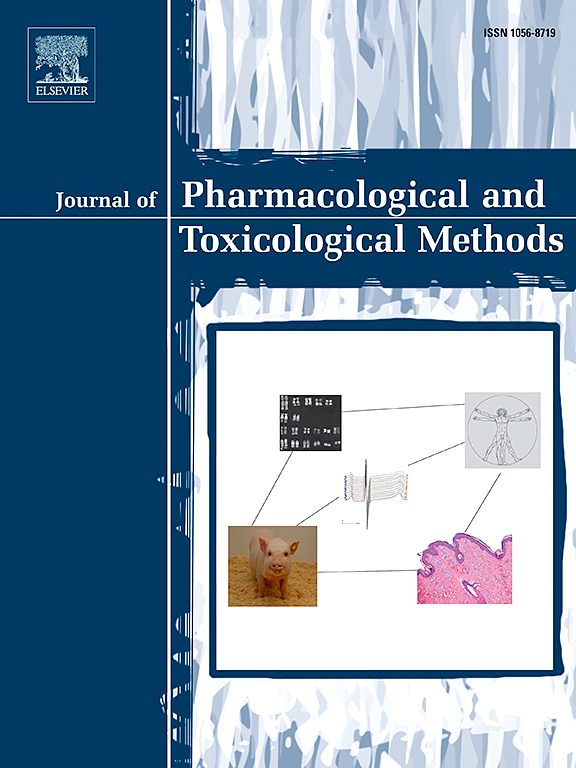狨猴(小型NHP):在毒理学研究中纳入安全药理学终点
IF 1.3
4区 医学
Q4 PHARMACOLOGY & PHARMACY
Journal of pharmacological and toxicological methods
Pub Date : 2025-05-01
DOI:10.1016/j.vascn.2025.107614
引用次数: 0
摘要
普通狨猴(Callithrix jacchus)是一种非人灵长类动物,已被用于生物医学研究。由于食蟹猴供应受限,以及2019冠状病毒病大流行期间性成熟动物的严重短缺,狨猴越来越多地用于生物治疗蛋白的毒性测试。然而,在狨猴毒理学研究中纳入安全药理学终点并不像食蟹鼠那样理想。因此,本研究的目的是测试一套套式遥测系统(DECRO系统),该系统可以同时记录自由运动的狨猴的呼吸、心电图和活动参数。10只动物(雌雄各5只)安装Decro系统,记录时间为14 h。评估所有动物的呼吸频率(RespR)、呼气和吸气次数、潮气量、分钟通气量、心电图分析和间隔计算、心率(HR)和活动水平(AL)。在光阶段,平均值±SEM人力资源和RespR变化从271年 ± 每分钟12击败(bpm)到318年 ± 14 bpm,从63年 ± 3呼吸每分钟(brpm)到73 ±2 brpm,分别基于在黑暗周期。阿尔几乎是零,人力资源和RespR减少到247 ± 12 bpm和53 ± 4 bpm,分别。使用软件提供的不同算法成功评估了所有剩余参数。总的来说,我们的结果提供了证据,证明没有由夹克引起的临床发现。这项初步研究产生了有希望的结果,支持在监管毒理学研究中使用这种夹套遥测系统的GLP软件版本,符合3Rs原则。随着这一发展,在药物开发中使用狨猴作为食蟹动物的替代品得到加强,特别是如果考虑到狨猴是极少数能够在健康动物中表现出药物诱导的点扭转的物种之一。本文章由计算机程序翻译,如有差异,请以英文原文为准。
Marmoset (a small size NHP): Incorporation of safety pharmacology endpoints in toxicology studies
The common marmoset (Callithrix jacchus) is a nonhuman primate species that is already used in biomedical research. Due to the constrained supply of Cynomolgus monkey and the acute shortage of sexually mature animals arisen during the COVID-19 Pandemic, the marmoset has been increasingly used for toxicity testing of biotherapeutic proteins. However, incorporating safety pharmacology endpoints in marmoset toxicology studies was not as optimal as in Cynomolgus. Therefore, the purpose of this study was to test a jacketed telemetry system (DECRO system) which enables the simultaneous recordings of respiratory, ECG and activity parameters in freely moving marmosets. Ten animals (5 females and 5 males) were fitted with the Decro system and recorded for 14 h. Respiratory rate (RespR), expiratory and inspiratory times, tidal volume, minute ventilation, ECG analysis and intervals calculation, heart rate (HR), and activity level (AL) were assessed in all animals. During the light phase, the mean values ± SEM of HR and RespR varied from 271 ± 12 beat per min (bpm) to 318 ± 14 bpm, and from 63 ± 3 breath per min (brpm) to 73 ± 2 brpm, respectively based on the AL. During the dark cycle where AL was nearly null, the HR and RespR decreased to 247 ± 12 bpm and 53 ± 4 bpm, respectively. All the remaining parameters were successfully assessed using the different algorithms provided by the software. Overall, our results provided evidence that there were no clinical findings caused by the jacket. This preliminary study yielded promising results to support the use of the GLP software version of this jacketed telemetry system, in line with the 3Rs principles, in regulatory toxicology studies. With this development, the use of marmosets as an alternative to Cynomolgus in drug development is reinforced especially if considering that marmosets are one of the very few species capable of showing drug-induced torsades de pointes in healthy animals.
求助全文
通过发布文献求助,成功后即可免费获取论文全文。
去求助
来源期刊

Journal of pharmacological and toxicological methods
PHARMACOLOGY & PHARMACY-TOXICOLOGY
CiteScore
3.60
自引率
10.50%
发文量
56
审稿时长
26 days
期刊介绍:
Journal of Pharmacological and Toxicological Methods publishes original articles on current methods of investigation used in pharmacology and toxicology. Pharmacology and toxicology are defined in the broadest sense, referring to actions of drugs and chemicals on all living systems. With its international editorial board and noted contributors, Journal of Pharmacological and Toxicological Methods is the leading journal devoted exclusively to experimental procedures used by pharmacologists and toxicologists.
 求助内容:
求助内容: 应助结果提醒方式:
应助结果提醒方式:


